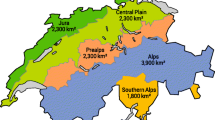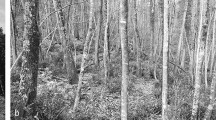Abstract
While the demand for forest recreation has been a topic covered in many studies, little attention has been paid so far to seasonal demand. In a forest context, the seasonal analysis is particularly interesting because of inter-temporal change in forest attributes throughout the year which can influence trip-taking behavior. In this paper, the model of seasonal forest visitation is developed to provide a richer understanding of the role played by seasonal fluctuation on a distribution of forest social benefits. The analysis is based on an on-site survey conducted in four forests in Poland. Results show that the most valuable forest trips are those taken in fall and that seasonal trips are separable.
Similar content being viewed by others
Abbreviations
- CS:
-
Consumer surplus
- CV:
-
Contingent valuation
- OLS:
-
Ordinary least squares
- TC:
-
Travel cost
References
Bartczak A, Lindhjem H, Navrud S, Zandersen M, Zylicz T (2008) Valuing forest recreation on the national level in a transition economy: the case of Poland. For Policy Econ 10: 467–472
Brainard J, Bateman I, Lovett A (2001) Modelling demand for recreation in English woodlands. Forestry 74(5): 423–438
Burt O, Brewer D (1971) Estimation of the net social benefits from outdoor recreation. Econometrica 39: 813–827
Croitoru L (2007) How much are Mediterranean forests worth. For Policy Econ 9: 536–545
Englin J, Nalle L (2005) Continuous endogenously stratified and truncated models. Paper presented at the methodological developments in revealed preference modeling for non-Market Valuation session at the American Association of agricultural economist’s meeting in Providence, Rhode Island, July 2005
Englin J, Lambert D (1995) Measuring angling quality in count data models of recreational fishing: a non-nested test of three approaches. Environ Resour Econ 6: 389–399
Englin J, Shonkwiler JS (1995a) Estimating social welfare using count data models: an application to long-run recreation demand under conditions of endogenous stratification and truncation. Rev Econ Stat 77(1): 104–122
Englin J, Shonkwiler JS (1995b) Modelling recreation demand in the presence of unobservable travel costs: toward a travel price model. J Environ Econ Manage 29: 368–377
Englin J, Boxall P, Watson D (1998) Modelling recreation demand in a Poisson system of equations: an analysis of the impact of international exchange rates. Am J Agric Econ 80: 255–263
Glowny Urzad Statystyczny, GUS (2009) Ochrona Srodowiska 2009, Warsaw
Scarpa R, Chilton SM, Hutchinson WG, Buongiorno J (2000) Valuing the recreational benefits from the creation of nature reserves in Irish forests. Ecol Econ 33(2): 237–250
Shaw D (1988) On-site samples’ regression: problems of non-negative integers, truncation and endogenous stratification. J Econ 37: 211–223
Von Haefen RH (2002) A complete characterization of the linear, log-linear, and semi-log incomplete demand system models. J Agric Resour Econ 27(2): 281–319
Vuong Q (1989) Likelihood ratio tests for model selection and nonnested hypotheses. Econometrica 57: 307–333
Zandersen M, Tol RSJ (2009) A meta-analysis of forest recreation values in Europe. J For Econ 15: 109–130
Author information
Authors and Affiliations
Corresponding author
Rights and permissions
About this article
Cite this article
Bartczak, A., Englin, J. & Pang, A. When are Forest Visits Valued the Most? An Analysis of the Seasonal Demand for Forest Recreation in Poland. Environ Resource Econ 52, 249–264 (2012). https://doi.org/10.1007/s10640-011-9527-1
Accepted:
Published:
Issue Date:
DOI: https://doi.org/10.1007/s10640-011-9527-1




